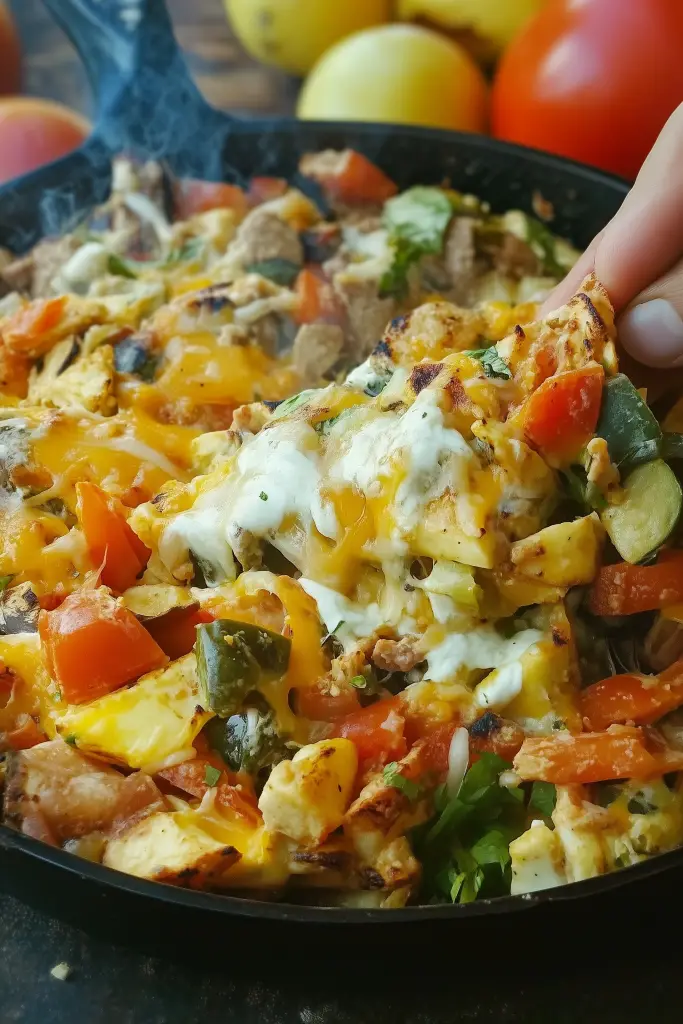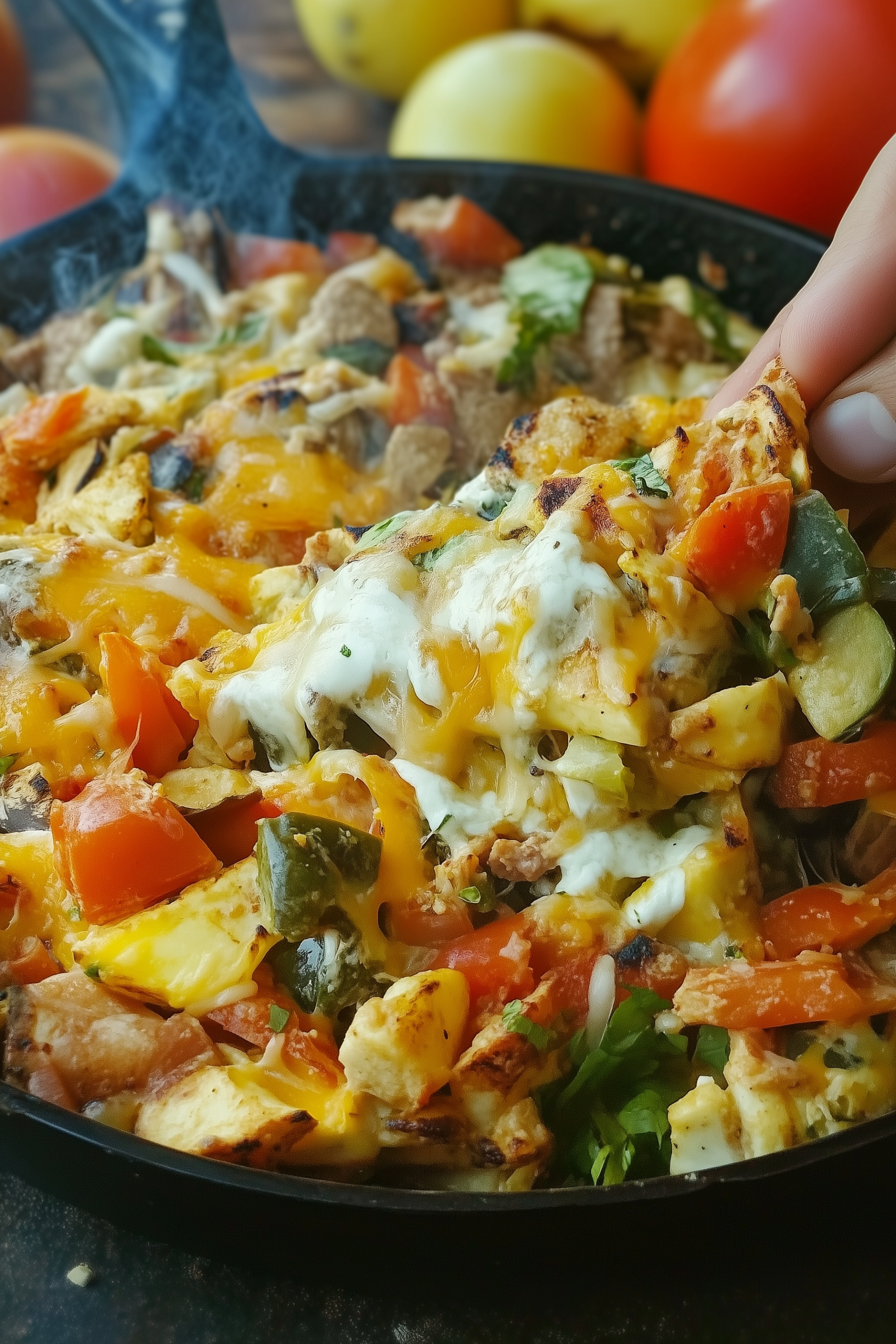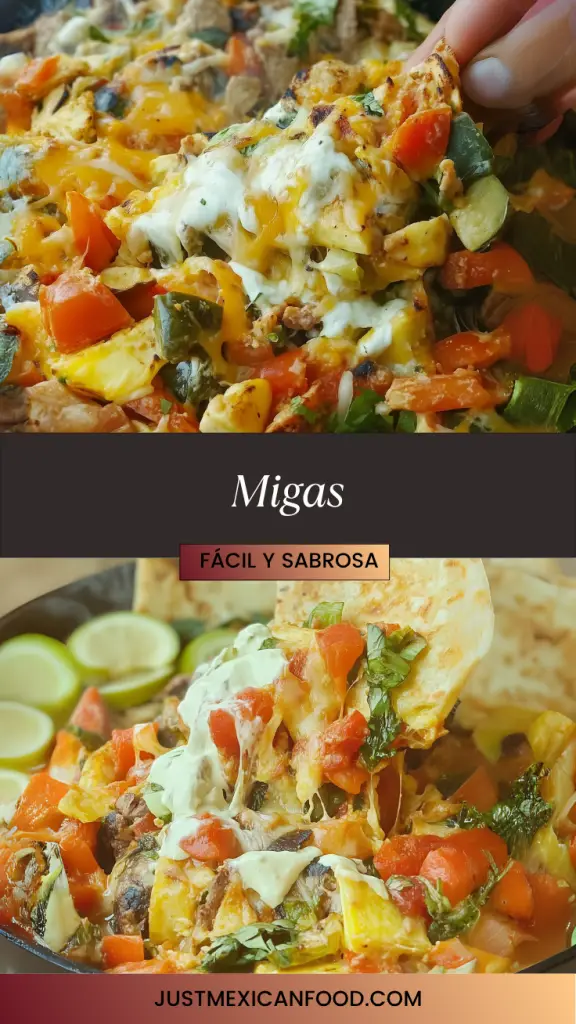If there’s one dish that instantly transports me back to lazy weekend mornings in my abuela’s kitchen, it’s Migas. The sound of tortillas sizzling in oil, the aroma of sautéed onions and jalapeños, and the comforting texture of soft scrambled eggs made every bite a warm hug in food form.
Migas is a humble yet flavorful Mexican breakfast dish made with crispy fried tortilla strips, eggs, and sautéed vegetables. It’s incredibly simple, incredibly satisfying, and incredibly versatile—making it the perfect meal for both summer brunches and cozy winter mornings.

Table of Contents
What Are Migas?
The word migas means “crumbs” in Spanish, and in traditional Mexican cuisine, this dish was a clever way to use up leftover tortillas. Chopped into pieces and fried until golden, tortillas provide a crispy contrast to soft eggs and melty cheese.
Unlike the Spanish version (which uses bread), Mexican Migas are made with corn tortillas and often include tomatoes, onions, jalapeños, and cheese. It’s a rustic dish that turns everyday ingredients into a breakfast that feels like a celebration.

Ingredients You’ll Need
Here’s what you’ll need for a 4-serving batch of authentic Mexican Migas:
-
10 corn tortillas, cut into small cubes or strips
-
¼ onion, finely diced
-
1 jalapeño, seeded and diced
-
1 tomato, diced
-
1 cup shredded cheese (optional; cheddar or queso Oaxaca works great)
-
6 large eggs
-
A splash of milk (about 2 tablespoons)
-
Salt and pepper, to taste
-
Cooking oil, for frying
Step-by-Step Instructions
Step 1: Prep the Tortillas
Cut the corn tortillas into small cubes or strips—whichever you prefer. Make sure they’re relatively uniform in size for even frying.
Step 2: Fry the Tortillas
In a large skillet, heat oil over medium-high heat. Working in two batches, fry the tortilla pieces until they are crispy and golden brown. Remove and drain on paper towels. While they’re frying, take a moment to dice your veggies.
Step 3: Sauté the Vegetables
Remove excess oil from the skillet, leaving about 1 tablespoon. Add the diced onion, tomato, and jalapeño. Cook over medium heat until the onions are translucent and the tomatoes have softened, about 5–7 minutes.
Step 4: Beat the Eggs
In a bowl, beat the eggs with a splash of milk. Season with a pinch of salt and pepper. The milk adds a creamy texture, but you can skip it for a firmer scramble.
Step 5: Combine Everything
Add the fried tortilla pieces back to the skillet with the cooked vegetables. Mix everything well to combine. Pour the beaten eggs over the mixture and stir gently until the eggs are cooked through but still soft—about 3–5 minutes.
Step 6: Add Cheese (Optional)
If using cheese, sprinkle it over the top just before serving. Let it melt slightly from the heat of the dish, or cover the skillet briefly to speed up the melting.
Why You’ll Love Migas
-
Quick and easy – Done in under 30 minutes with pantry staples.
-
Budget-friendly – Made from simple, affordable ingredients.
-
Customizable – Add beans, avocado, salsa, or chorizo.
-
Perfect any time of year – Light enough for summer, comforting enough for winter.
Serving Suggestions
Migas is traditionally served for breakfast or brunch, but don’t let that limit you. Here are some great pairings and serving ideas:
-
With refried beans: A classic side for added protein.
-
Fresh avocado or guacamole: Creamy contrast to the crispy tortillas.
-
Hot sauce or salsa verde: For an extra kick of flavor.
-
Warm flour or corn tortillas: Turn it into breakfast tacos!
You can also serve Migas with a side of fruit for a balanced morning meal, or even a michelada or café de olla for a weekend brunch treat.
Tips for the Best Migas
-
Use day-old tortillas: They fry better and absorb less oil.
-
Don’t overcook the eggs: Keep them soft to balance the crispy tortillas.
-
Watch the heat: Jalapeños can vary in spice—taste before adding more.
-
Add cheese last: It melts best when sprinkled over hot eggs just before serving.
Variations
Migas is incredibly adaptable. Here are a few fun ways to switch it up:
-
Tex-Mex Style: Add bell peppers, chorizo, and a bit of cumin.
-
Migas con Frijoles: Stir in cooked black or pinto beans.
-
Green Chile Migas: Swap jalapeños for roasted Hatch chiles.
-
Vegan Migas: Use tofu scramble and vegan cheese.
How to Store and Reheat
While Migas is best fresh, leftovers can be stored and reheated:
-
Refrigerator: Store in an airtight container for up to 2 days.
-
Reheat: Warm gently in a skillet. Add a splash of milk or stock to keep the eggs soft.
-
Avoid microwaving: It softens the crispy tortillas too much.
Final Thoughts
There’s a reason Migas has been a breakfast favorite across Mexican households for generations. It’s hearty, delicious, and endlessly comforting—just the kind of meal that brings people together around the kitchen table. Whether you make it on a slow Sunday morning or whip it up for a quick weekday dinner, it’s a dish that always delivers.
So grab those leftover tortillas, crack some eggs, and enjoy a plateful of this comforting classic. And if you love it as much as I do, don’t be surprised if Migas becomes a regular in your kitchen too.

Migas
Ingredients
Method
- Cut the corn tortillas into small cubes or strips—whichever you prefer. Make sure they’re relatively uniform in size for even frying.
- In a large skillet, heat oil over medium-high heat. Working in two batches, fry the tortilla pieces until they are crispy and golden brown. Remove and drain on paper towels. While they’re frying, take a moment to dice your veggies.
- Remove excess oil from the skillet, leaving about 1 tablespoon. Add the diced onion, tomato, and jalapeño. Cook over medium heat until the onions are translucent and the tomatoes have softened, about 5–7 minutes.
- In a bowl, beat the eggs with a splash of milk. Season with a pinch of salt and pepper. The milk adds a creamy texture, but you can skip it for a firmer scramble.
- Add the fried tortilla pieces back to the skillet with the cooked vegetables. Mix everything well to combine. Pour the beaten eggs over the mixture and stir gently until the eggs are cooked through but still soft—about 3–5 minutes.
- If using cheese, sprinkle it over the top just before serving. Let it melt slightly from the heat of the dish, or cover the skillet briefly to speed up the melting.

